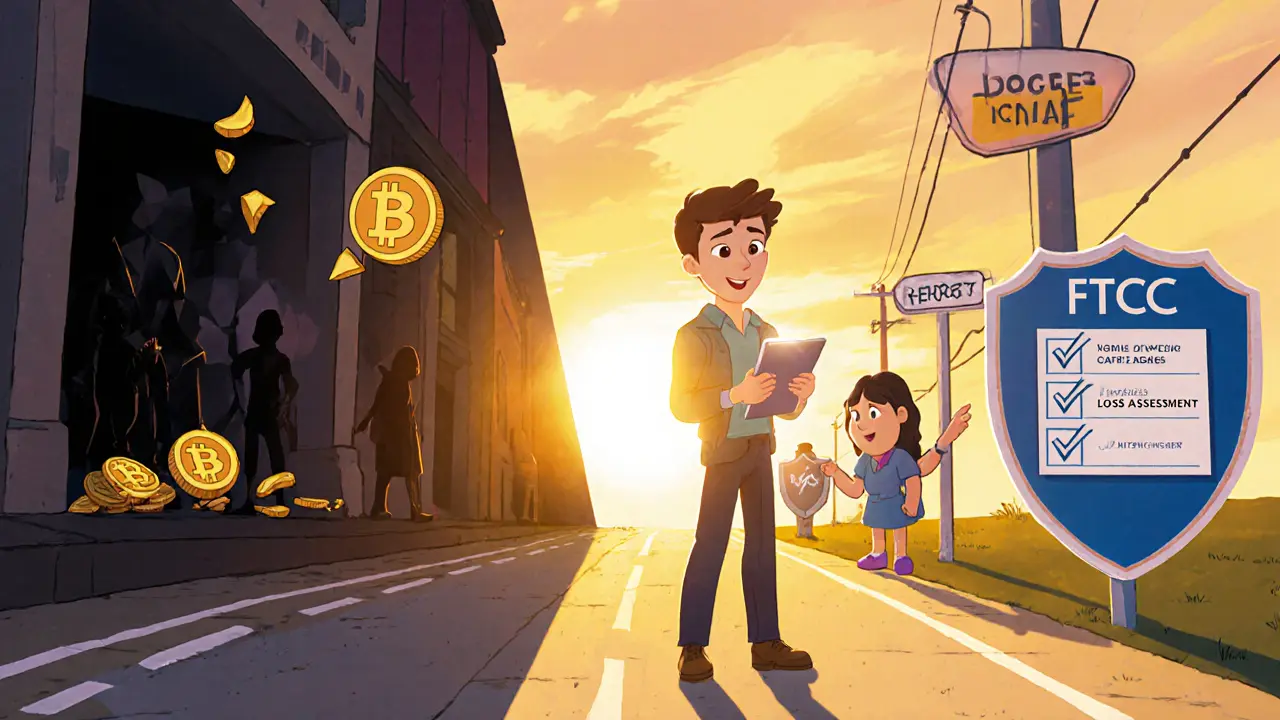Crypto Scam Red Flag Detector
How to spot a cryptocurrency scam
This tool helps you identify red flags in crypto projects based on common scam indicators. Enter your answers to see if the token has potential risks.
Scam Risk Assessment
When you see a coin called Department of Government Efficiency crypto and a ticker that reads DOGE, you might wonder if the U.S. government actually backs a new digital currency. The short answer? No. The token is a classic example of a government‑themed scam that rides on the popularity of the real Dogecoin and the hype around blockchain projects.
What the token claims to be
Department of Government Efficiency (DOGE) is marketed as a cryptocurrency created to improve government operations and boost fiscal efficiency. The website dogegov.com mimics official government branding, uses phrases like “executive order” and even shows a fake white‑house seal. In reality, there is no U.S. agency called the Department of Government Efficiency, and no federal budget has ever been allocated to a crypto project with that name.
Technical specs - just another ERC‑20 token
The token lives on the Ethereum blockchain as a standard ERC‑20 contract (address 0x1121...98AAc5). It has 18 decimal places, a circulating supply of about 979.12million DOGE, and a hard cap of 1billion tokens. There are no special features: no governance layer, no staking, no cross‑chain bridges, and no audited smart‑contract code from reputable firms like CertiK or Hacken.
Market performance to date
According to CoinMarketCap data from October142025, the token trades around $0.004255, giving it a market cap of roughly $4.16million. That’s a 99% drop from its all‑time high of $0.5154 reached in November2024. Daily volume hovers near $1.11million, but most of that activity appears to be wash‑trading - large buy‑sell cycles that create the illusion of liquidity while the actual ETH backing the liquidity pool is only about 23.7ETH (≈$67k).
Red flags that scream “scam”
- Fake government documentation - the project fabricates executive orders, complete with bogus reference numbers that don’t exist in any federal coding system.
- Lack of a whitepaper or verifiable team - the website has no “About Us” page with real names, LinkedIn profiles, or developer histories.
- Concentrated ownership - the top 10 wallets hold 47% of the total supply, a classic sign of a pump‑and‑dump setup.
- No security audit - reputable auditors have not examined the contract, leaving potential backdoors unchecked.
- Heavy bot involvement - TokenSniffer reports that 87% of social‑media mentions come from automated accounts.

How it compares to real Dogecoin and legitimate government tech
| Aspect | Department of Government Efficiency (DOGE) | Dogecoin (DOGE) | U.S. Digital Service (real agency) |
|---|---|---|---|
| Launch date | August2024 | December2013 | 2014 (federal establishment) |
| Blockchain | Ethereum (ERC‑20) | Bitcoin‑derived proof‑of‑work | Not a blockchain project |
| Market cap (Oct2025) | $4.16M | $15.3B | N/A |
| Official backing | None - false claims | Community‑driven, accepted by merchants | U.S. federal government |
| Utility | None documented | Payments, tipping, fundraising | Improve federal digital services |
The table makes it clear: the so‑called Department of Government Efficiency token offers no real use case, no official support, and a market footprint that barely registers beyond the noise of speculative trading.
Regulatory scrutiny and legal risks
U.S. regulators have taken notice. In September2025 the Federal Trade Commission issued Consumer Alert#2025‑44, naming the token as part of “Operation FakeGovCoin.” The CFTC filed an emergency action on October102025 seeking to halt all trading of the token in U.S. courts, citing market manipulation and impersonation of a government entity. The Department of Justice’s “Operation TokenTruth” has already led to 17 indictments of creators behind similar scams. If you’re holding the token, you could become entangled in a legal investigation - a risk most investors simply aren’t prepared for.
Investor guide - what to do if you’ve bought DOGE
If you already own some of the scam token, here’s a practical checklist:
- Assess the loss. Pull the exact balance from a block explorer (Etherscan) and calculate current USD value using the latest price from CoinGecko.
- Avoid panic selling during a pump. Most price spikes are followed by a rapid dump - waiting a few hours can prevent selling at the absolute bottom.
- Document everything. Save transaction hashes, screenshots of promotional material, and any communications you received. This can help if authorities later request evidence.
- Report the scam. File a complaint with the FTC (reportfraud.ftc.gov) and with your local cybersecurity agency.
- Secure your wallet. Move any unrelated assets to a new address to prevent future phishing attempts.
Most importantly, treat the loss as a hard‑earned lesson about the red flags listed earlier. Future investments should be limited to tokens with transparent teams, audited contracts, and clear utility.

How to spot government‑themed crypto scams in the future
Keep an eye on these quick‑check items:
- Does the project claim an official government partnership without a press release from a known agency?
- Is there a verifiable whitepaper, GitHub repo, and team members with professional histories?
- Are the smart‑contract addresses audited by a reputable firm?
- Do the token’s social media accounts show a high percentage of bot‑generated posts?
- Is the token’s ticker identical or very similar to an existing, well‑known coin?
If you answer “yes” to many of these, walk away.
Bottom line for curious readers
The Department of Government Efficiency token is a textbook pump‑and‑dump scam that exploits the credibility of government language and the familiarity of the DOGE ticker. It carries no genuine utility, lacks any official endorsement, and is under active investigation by multiple U.S. agencies. The safest move is to stay clear of it and focus on projects that demonstrate real transparency and value.
Frequently Asked Questions
Is the Department of Government Efficiency token officially linked to the U.S. government?
No. There is no federal agency called the Department of Government Efficiency, and no official budget or legislative approval backs this token.
How can I verify if a cryptocurrency’s smart contract is audited?
Check reputable audit firms like CertiK, Hacken, or OpenZeppelin for a published report. The report should include a contract address, methodology, and identified issues. If no audit exists, treat the token as high risk.
What should I do if I’ve already bought this token?
Follow the checklist in the “Investor guide” section: assess loss, avoid panic sells, document all evidence, report to the FTC, and move any other assets to a secure wallet.
Why do scammers use government‑related names?
Government language suggests legitimacy and authority, which lowers investors’ suspicion. The rise of such scams in 2025 (up 320% year‑over‑year) shows they’re effective at attracting quick‑turn traders.
Is there any legitimate use case for this token?
No. The token provides no payment gateway, smart‑contract functionality, or integration with any platform. All activity is purely speculative.




10 Comments
Pierce O'Donnell
Another gov‑themed meme coin? Yeah, the same tired playbook: flashy branding, zero utility, and a promise of “efficiency” that evaporates faster than the token price.
Vinoth Raja
The allure of state‑linked cryptos often masquerades as a technocratic solution, yet the underlying tokenomics reveal a classic Ponzi architecture. By co‑opting regulatory language, these projects engineer a veneer of legitimacy that seduces the uninformed. In practice, the ERC‑20 scaffolding offers no governance layer, which contradicts the proclaimed “efficiency” narrative. Such dissonance is a symptom of broader epistemic erosion in the decentralized finance discourse.
Kaitlyn Zimmerman
Skip it – no real use case and a likely scam.
DeAnna Brown
Look, folks, this so‑called Department of Government Efficiency token is nothing more than a sham that hijacks our national symbols for profit. The fake white‑house seal and fabricated executive orders are blatant attempts to exploit patriotism. Real government tech initiatives are transparent and vetted, unlike this pump‑and‑dump scheme. If you care about the integrity of American finance, stay far away from this garbage. It’s a disgrace to genuine blockchain innovators.
Chris Morano
You're right, the misuse of official imagery is a red flag. It’s important we call out these tactics so others don’t fall victim.
Ikenna Okonkwo
The pattern mirrors historical frauds where authority is simulated to mask underlying volatility. By dissecting the contract audit gaps, we expose the systemic risk hidden beneath the hype.
Hailey M.
Wow, a government token? 🙄 Let’s just hope the “efficiency” translates to *instant* riches… not.
Schuyler Whetstone
LOL you fell for the hype lol this is just another sctam bro, dont trust any of them.
David Moss
Sure, but have you considered that the very *entities* behind the FTC alert might be part of a larger cover‑up? The truth is often buried deep beneath layers of government‑sponsored misinformation.
Bobby Lind
Looks like another classic case-good thing we have watchdogs keeping an eye on these scams.